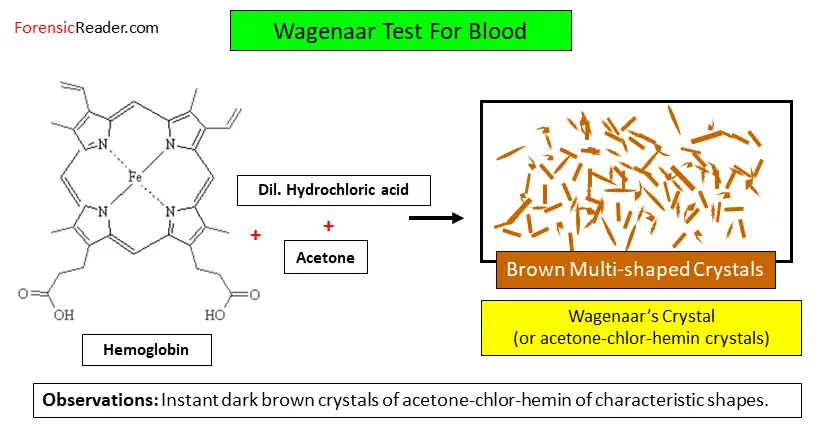Wagenaar is a crystal assay confirmatory test for blood that uses a mixed preparation of acetone and chloride ions to form acetone-chlor-hemin crystals. It was first developed in 1935 by M. Wagenaar. It is easy to perform and confirms whether the given fluid/stain is blood or not.
Who Invented Wagenaar Test?
It was developed by M. Wagenaar in 1935. But it wasn’t popular until Hausser mentioned this technique in his reference book in 1938 that became widely known.
Lastly, in 1940, Chiodi performed an extensive study using this test on different sets of human and animal blood in adverse conditions. He later proposed that the Wagenaar test is better than the Teichmann test for blood.
But it didn’t end well.
In a study by Stasi (1945), he reported that in some cases the test doesn’t identify blood in the sample. That became the reason why this test is currently not forensically reliable as compared to other crystal tests.
Principle of Wagenaar Test
The principle of this test depends on the active reaction between acetone, and chloride ions from hydrochloric acid with the hemin. This allows a combined reaction among all to form a special Wagenaars crystal or acetone-chlor-chloride crystals.

Reagent of Wagenaar’s Test
There are two main chemicals needed:
- Acetone
- Hydrochloric acid
Preparation of Acetone Chlor-Hemin Crystals (Procedure)
- Place a small amount of bloodstain on a glass slide.
- Using a dropper, add a few drops of acetone over the bloodstain.
- Add a drop of dilute hydrochloric acid.
- Observe under a standard microscope.
Observation
- Instant development of acetone-chlor-hemin microcrystals
- Dark brown crystals
- Multi-shaped crystals
Forensic Importance of Wagenaar Test
- Confirmatory test for blood
- Works with dried blood stains
- Less chance of getting a false-positive result
Advantages of Wagenaar Test
- Easy to perform
- No heating is necessary
- Less time consuming
- Only two basic reagents are required
Disadvantages of Wagenaar Test
- Crystals are harder to interpret.
Note: Crystals are harder to interpret because the test produces two sets of derivatives such as haematin and hemin. This result is less availability of hemin crystals for the development of acetone-chlor-hemin crystals.
Check Your Knowledge
1. Confirmatory tests for blood are
(i) Luminal test (ii) Hemin crystal test (iii) Wagenaar test (iv) Spectroscopic examination
- (ii), (iii) and (iv) are correct
- (i) and (iv) are correct
- (ii) and (iv) are correct
- (i) and (iii) are correct
2. Which of the following is right combination of reagent for Wagennar test?
- Acetone, Hydrogen chloride
- Acetone and Hydrochloric acid
- Acetone and Hexachloropentane
- Acetone and chloroform
3. When and who invented the Wagenaar Test?
- M. Wagenaar, 1935
- N. Wagenaar, 1935
- M. Wagenaar, 1938
- N. Wagenaar, 1938
Reference:
- Anil Aggrawal, The Textbook of Forensic Medicine and Toxicology
- Wagenaar, M. 1929. Contributions to microscopic, microspectroscopic, and quantitative blood tests. Fresenius Z Anal Chem. p101-113.
- Wagenaar, M. 1937. A New Procedure for Criminalistic Blood Detection.
- Sourcebook in Forensic Serology, Immunology, and Biochemistry [Book]
Continue Reading:
- Tetramethylbenzidine (TMB) Test: Principle, Reagent and Procedure
- Cavett Test of Ethanol Estimation And Forensic Importance
- Takayama Test For Blood: Principle, Reagent, Procedure, Advantages, and Disadvantages

FR Author Group at ForensicReader is a team of Forensic experts and scholars having B.Sc, M.Sc, or Doctorate( Ph.D.) degrees in Forensic Science. We published on topics on fingerprints, questioned documents, forensic medicine, toxicology, physical evidence, and related case studies. Know More.
